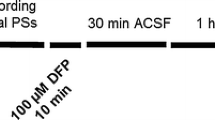Abstract
The effect of MKC-231 on acetylcholine (ACh) synthesis and release was studied in the hippocampus of normal and AF64A-treated rats. AF64A (3 nmol/brain, i.c.v.) produced significant reduction of high-affinity choline uptake (HACU) and high K+-induced ACh release in hippocampal synaptosomes. Treatments with MKC-231 (10−8 and 10−7 M) showed significant reverse of the decrease in both HACU and ACh release. In hippocampal slices superfused with choline-containing artificial cerebro-spinal fluid (ACSF), high K+-induced ACh release was gradually decreased by repeated alteration of resting and high K+ stimulations in AF64A-treated rats. However, addition of MKC-231 (10−8 to 10−7 M) in the superfusate reduces this decrease. In vivo microdialysis studies indicate MKC-231 (10 mg/kg, p.o.) significantly reversed reduction of basal ACh concentrations in AF64A-treated rats, measured by radioimmunoassay without a cholinesterase inhibitor in the perfusate. These results indicate MKC-231 improves AF64A-induced cholinergic hypofunction by enhancing HACU, subsequently facilitating ACh synthesis and release in vitro and in vivo.






Similar content being viewed by others
References
Aarsland D, Mosimann UP, McKeith IG (2004) Role of cholinesterase inhibitors in Parkinson’s disease and dementia with Lewy bodies. J Geriatr Psychiatry Neurol 17:164–171
Bessho T, Takashina K, Tabata R, Oshima C, Chaki H, Yamabe H, Egawa M, Tobe A, Saito K-I (1996) Effects of the novel high affinity choline uptake enhancer 2-(2-oxopyrrolidin-1-yl)-N-(2, 3-dimethyl-5, 6, 7, 8-tetrahydrofuro[2, 3-b]quinolin-4-yl) acetoamide on deficits of water maze learning in rats. Arzneimittelforschung 46:369–373
Buyukuysal RL, Holmes T, Wurtman RJ (1991) Interactions of 3, 4-diaminopyridine and choline in stimulating acetylcholine release and protecting membrane phospholipids. Brain Research 541:1–6
Chrobak JJ, Hanin I, Schmechel TJ, Walsh TJ (1988) AF64A-induced working memory impairment: behavioral, neurochemical and histological correlates. Brain Res 463:107–117
Coleman PD, Yao PJ (2003) Synaptic slaughter in Alzheimer’s disease. Neurobiol Aging 24:1023–1027
Collerton D (1986) Cholinergic function and intellectual decline in Alzheimer’s disease. Neuroscience 19(1):1–28
De Bore P, Westerink BHC, Horn AS (1990) The effects of acetylcholine from the striatum in vivo: interaction with autoreceptor responses. Neurosci Lett 116:357–360
Fisher A, Mantione CR, Abraham DJ, Hanin I (1982) Long-term central cholinergic hypofunction induced in mice by ethylcholine aziridinium ion (AF64A) in vivo. J Pharmacol Exp Ther 222:140–145
Gower AJ, Rousseau D, Jamsin P, Gobert J, Hanin I, Wulfert E (1989) Behavioral and histological effects of low concentrations of intraventricular AF64A. Eur J Pharmacol 166:271–281
Hortnagl H (1994) AF64A-induced brain damage and its relation to dementia. J Neural Transm Suppl 44:245–257
Jarrard LE, Kant GJ, Meyerhoff JL, Levy A (1984) Behavioral and neurochemical effects of intraventricular AF64A administration in rats. Pharmacol Biochem Behav 21:273–80
Kasa P, Rakonczay Z, Gulya K (1997) The cholinergic system in Alzheimer’s disease. Prog Neurobiol 52:511–535
Kawashima K, Sato A, Yoshizawa M, Fujii T, Fujimoto K and Suzuki T (1994) Effects of the centrally acting cholinesterase inhibitors tetrahydroaminoacridine and E2020 on the basal concentration of extracellular acetylcholine in the hippocampus of freely moving rats. Naunyn-Schmiedeberg’s Arch Pharmacol 350: 523-528
Kawashima K, Hayakawa T, Kashima Y, Suzuki T, Fujimoto K, Oohata H (1991) Determination of acetylcholine release in the striatum of anesthetized rats using in vivo microdialysis and radioimmunoassay. J Neurochem 57:882–887
Krištofiková Z, Fales E, Majer E, Klaschka J (1995) (3H) Hemicholinium-3 binding sites in postmortem brains of human patients with Alzheimer’s disease and multi-infarct dementia. Exp Gerontol 30:125–136
Leventer S, McKeag D, Clancy M, Wulfert E, Hanin I (1985) Intracerebroventricular administration of ethylcholine mustard aziridinium ion (AF64) reduces release of acetylcholine from rat hippocampal slices. Neuropharmacology 24:453–459
Murai S, Saito H, Abe E, Masuda Y, Odashima J, Itoh T (1994) MKC-231, a choline uptake enhancer, ameliorates working memory deficits and decreased hippocampal acetylcholine induced by ethylcholine aziridinium ion in mice. J Neural Trasm 98:1–13
Paxinos G, Watson C (1986) The rat brain in stereotaxic coordinates, 2nd ed. Academic Press, New York
Potter PE, Nitta S (1993) Alterations in modulation of acetylcholine release following lesion of hippocampal cholinergic neurons with the neurotoxin AF64A. Neuropharmacology 32:519–526
Rodriguez-Puertas R, Pazos A, Zarranz JJ, Pascual J (1994) Selective cortical decrease of high-affinity choline uptake carrier in Alzheimer’s disease: autoradiographic study using 3H-hemicholinium-3. J Neural Transm 8:161–169
Rylett RJ, Ball MJ, Colhoun EH (1983) Evidence for high affinity choline transport in synaptosomes prepared from hippocampus and neocortex of patients with Alzheimer’s disease. Brain Res 289:169–175
Scheff SW, Price DA (2003) Synaptic pathology in Alzheimer’s disease: a review of ultrastructural studies. Neurobiol Aging 24(8):1029–1046
Schliebs R, Arendt T (2006) The significance of the cholinergic system in the brain during aging and in Alzheimer’s disease. J Neural Transm 113(1):1625–1644
Sims NR, Bowen DM, Allen SJ, Smith CCT, Neary D, Thomas DJ, Davison AN (1983) Presynaptic cholinergic dysfunction in patients with dementia. J Neurochem 40(2):503–509
Smith G (1988) Animal models of Alzheimer’s disease: experimental cholinergic denervation. Brain Research Review 13:103–118
Stip E, Chouinard S, Boulay LJ (2005) On the trail of a cognitive enhancer for the treatment of schizophrenia. Prog Neuropsychopharmacol Biol Psychiatry 29:219–232
Terry AV Jr., Buccafusco JJ (2003) The cholinergic hypothesis of age and Alzheimer’s disease-related cognitive deficits: Recent challenges and their implications for novel drug development. J Pharmacol Exp Ther 306:821–827
Ulus IH, Wurtman RJ, Mauron C, Blusztajn JK (1989) Choline increases acetylcholine release and protect against the stimulation-induced decrease in phosphatide levels within membrane of rat corpus striatum. Brain Research 484:217–227
Acknowledgments
The authors thank Prof. Koichiro Kawashima and Dr. Kazuko Fujimoto (Department of Pharmacology, Kyoritsu College of Pharmacy, Tokyo) for their invaluable technical advices and support for the microdialysis study and RIA assays for ACh.
Author information
Authors and Affiliations
Corresponding author
Rights and permissions
About this article
Cite this article
Takashina, K., Bessho, T., Mori, R. et al. MKC-231, a choline uptake enhancer: (2) Effect on synthesis and release of acetylcholine in AF64A-treated rats. J Neural Transm 115, 1027–1035 (2008). https://doi.org/10.1007/s00702-008-0048-1
Received:
Accepted:
Published:
Issue Date:
DOI: https://doi.org/10.1007/s00702-008-0048-1




